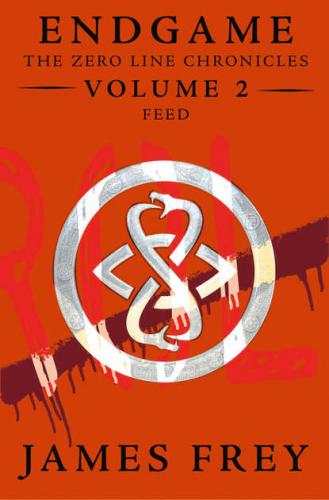First published in ebook in Great Britain by HarperCollins Children’s Books 2016
HarperCollins Children’s Books is a division of HarperCollinsPublishers Ltd
1 London Bridge Street, London SE1 9GF
Endgame: The Zero Line Chronicles: Feed © 2016 by Third Floor Fun, LLC
Cover design and logo by Rodrigo Corral Design
Additional logo and icon design by John Dismukes
James Frey asserts the moral right to be identified as the author of this work
A catalogue record for this book is available from the British Library.
All rights reserved under International and Pan-American Copyright Conventions. By payment of the required fees, you have been granted the non-exclusive, non-transferable right to access and read the text of this e-book on screen. No part of this text may be reproduced, transmitted, down-loaded, decompiled, reverse engineered, or stored in or introduced into any information storage and retrieval system, in any form or by any means, whether electronic or mechanical, now known or hereinafter invented, without the express written permission of HarperCollins.
Source ISBN: 9780062332714
Ebook Edition © April 2016 ISBN: 9780007585298
Version: 2016-04-07
Contents
Excerpt from Endgame: The Calling
I knelt in the rocks, sharp stones digging into my knees and shins, and placed the bomb. It was small, about the size of two bricks, and was contained inside a cardboard box. There wasn’t much to it: a chunk of C4—a plastic explosive with the consistency of soft clay—a few components of an alarm clock, and four D-size batteries. I took the two wires from the clock, twisted them onto the leads of the detonators—short metal cylinders. I pushed the detonators into the C4.
C4 was supposed to be extremely stable—you could drop it or shoot it or rip it in half, and it wouldn’t explode. It needed an electric current to detonate. And I’d just given it that electric current. It was ready to blow, and sweat dripped down my forehead onto my nose and into my eyes.
This wasn’t the first time that I’d done this: I’d prepped a dozen practice bombs, where the C4 was replaced with Play-Doh. This was the first time I’d done it for real, though: real batteries, real detonators, real explosive. My fingers trembled with every step.
I looked over at Kat. She was older than me by five years: 24. She was tall and pretty, with brown hair that shone like copper in the evening sun. Eugene was with her, the two of them unrolling a tarp that had been painted with a thick and heavy coat of thermite. The design was a spiraling series of rectangles—the logo for the Munich Olympics. At the bottom was painted “9-5-1972.”
This was how we would “invite” the Players to meet with us. John and Walter didn’t know for certain how a real Calling worked. Walter had said that the Cahokians believed that there would be a sign from heaven—possibly something violent. The only thing they knew for sure was that it would be unmistakable, and the Players would know where they were to gather. So we’d use bombs to get their attention, and use the thermite to burn the Olympic logo into the ground.
When they had the tarp unrolled, Eugene unrolled the fuse and pulled out a lighter.
I hit the timer on the clock, and it started to count down.
I stood up and walked to them. Eugene touched the unlit lighter to the fuse, and we all headed for the trees. As we walked, Bakr, the man who’d made the bombs, walked past me, heading toward the bomb to check it.
Eugene held his hand out to me, and I slapped it, reluctantly.
“Nice job, man,” he said.
“Let’s see what Bakr says,” Kat said, stopping at the tree line and turning around.
I looked back at him, 30 yards away in a natural low spot in the forest. It was muddy in the middle, which we’d worked around, but he had boots on and walked right through the mud, just as he’d done for the other groups who had practiced this exercise. We were now the eighth group to practice with the real equipment. Four more to go. All the Zero line members were getting their chance, because practicing with Play-Doh was one thing but sticking detonators into real C4 was something completely different. I hadn’t expected to be so intimidated by the bomb.
Bakr
